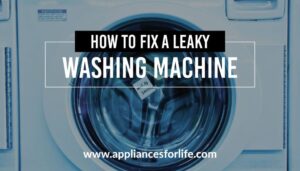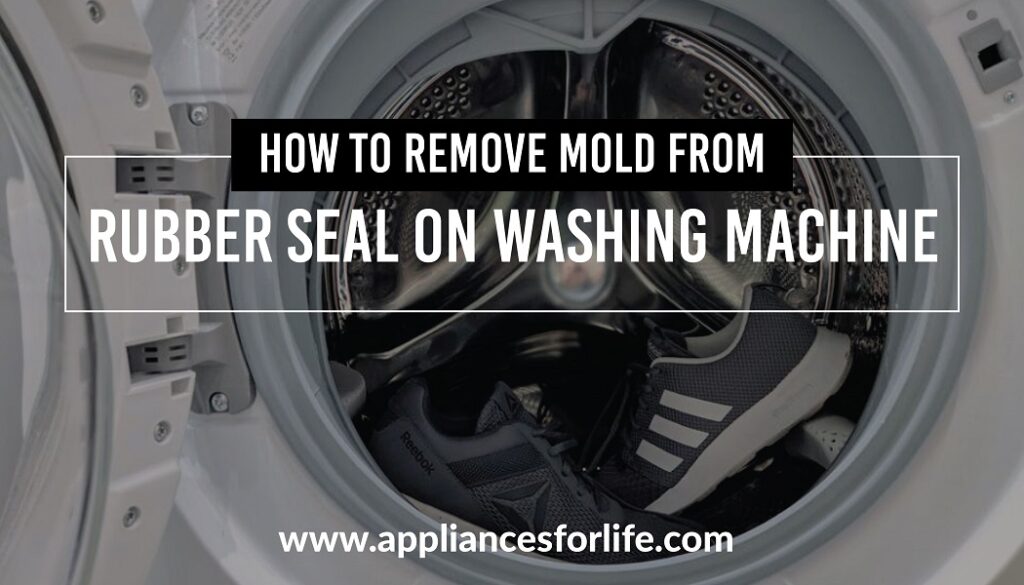- As a washing machine owner, you need to know how to remove mold from rubber seal as part of your routine maintenance of the washer to keep it functioning at the highest level. In this article, we’ll be exploring how to remove mold from rubber seal on washing machine.
We all know the washing machine’s most important and only function is to efficiently clean our clothes, although the level of efficiency now depends on the quality of the washer you invest in. Understandably, washing machines are available in different types, capacities, and prices, so if you’re getting a washer that is not as sophisticated as the other, you can’t expect it to be as efficient, although efficiency is not something you should compromise on if it’s very important for you. The point is, as much as the primary function of a washer is to clean, just like every other household appliance, the washer also needs to be cleaned to keep it functioning at the highest level.
Table of Contents
ToggleBeing one of the most important appliances in the house, the washing machine has to be properly maintained, and considering what some of them cost, it shouldn’t be a problem dedicating some minutes to perform routine checks on your washing to protect your investment. Maintaining your washing machine regularly includes checking the most important parts of the washer for any odd signs, cleaning the washing machine with recommended washing machine cleaners, loading it with the right amount of clothes, and many more. Cleaning is never easy, but thinking of the greater good it can do should be enough to motivate you to protect your investment by regularly cleaning your washer and other household appliances.
The washing machine market is one of the fastest-growing markets in the appliance industry, alongside the refrigerator, blender, and cooking range. People are beginning to realize how important the washing machine is, hence the reason why the market has been growing exponentially in the past few years, not just in the United States but also in other parts of the world. According to the information provided by Research Gate, Australia has a 98% ownership rate of washing machines, which means that almost every household in the country has a washing machine, even more than the United States, although the latter has more population.
Despite being a washing machine that is tasked with cleaning clothes and other related items, you still need to regularly clean the washer if you want to avoid issues like mold building up and eventually the machine if not cleaned properly. It is only natural that mold grows in your washing machine because it only grows on a moist surface which is not unusual considering how the washing machine needs water to wash whatever you put in it. In this case, the washing machine rubber seals are often affected the most because water and detergent flow through them anytime, and if you don’t clean them as soon as possible, it may result in a bad smell affecting your clothes which you won’t be too happy about.
Knowing how to get mold out of washing machine rubber will save you from a lot of things that can affect the quality of your clothes and also the machine because you’ll always get a bad smell on your clothes most times when you have mold in your washing machine. Removing mildew from rubber can be done in different ways which include investing in a washing machine mold remover gel or a mold cleaner for washing machines as most people love to call it. When a washing machine smells moldy, you should know you’re not doing enough to clean the rubber seals which mostly house the mode because of the presence of excess water that runs through it.
Since front-loading washers use more water than top-loading washers, they’re to have smelly build-ups of both mildew and mold that will make your clothes smell unpleasantly even when they’ve just been washed. When water gets trapped in the rubber gasket around the time without proper and regular cleaning, it causes mold and mildew to start growing and it’s only a matter of time before it starts taking a toll on your clothes as they’ll also begin to smell unpleasant. Although knowing how to clean black mold on rubber or mold in front loader washers is amazing, it’s safe to know that mold is not the only thing that causes your washer to smell.
Before we start discussing how to remove mold from rubber seal on washing machine, let’s explore other things that cause your washer to smell and how you can get rid of them.
What Causes the Washing Machine to Smell?
If the machine tasked with cleaning your clothes and other washable items starts smelling bad, you should know something is wrong and make a move to correct the problem as soon as possible. You can’t imagine the number of people that complain their washing machines smell bad, and this is frustrating because these machines are meant for washing and not otherwise. This can’t entirely be blamed on the washer as most of the reasons why a washing machine smells badly is people’s lack of proper attention to their washer’s needs, which include proper maintenance.
The bad thing about a smelly washing machine is that it won’t be the only one smelling. As soon as you put your clothes in it to be washed, you won’t get a good smell when you’re bringing them out, which goes against the primary objective of every washing machine. Since the washer cannot take care of itself, you’ll need to pay a little more attention to the maintenance routine by exploring different possibilities and going ahead to find a good solution to put an end to this problem.
Some of the major causes of a smelly washing machine include;
Poor drainage system
It’s easy to point all hands at the washer itself for smelling bad, but the truth, as much as it’s hard to digest, is that the washer can’t take care of itself however automatic its functionality might seem. When a washer has a poor drainage system, you should all but expect a bad odor because bad water accumulates in the machine, causing it to start smelling bad after some time. The problem with some machines is that they don’t have effective draining hoses, and as a result, the water that’s meant to be put away stays back in the drum and starts smelling after a while.
As a washing machine owner, it is your responsibility to ensure that your washer has a proper drainage system, for the sake of all parties involved, including yourself. Having a good drainage system means that you’ve eliminated one of the possible causes for a bad smell in the washing machine, and if you pay proper attention to the rest, perhaps you can have an odor-free washer. Another thing you should know is that stagnant water can also cause bacteria, slime, soap scum, and mold, all of which are not nice for your washer at all.
Temperature
Another thing you should pay attention to when your washing machine starts smelling is the temperature you always wash with. It is generally believed that washing at a low temperature can help you save a lot of money on your electricity bill as it makes your washer more energy-efficient, and rightly so. However, if you do this too frequently, it’s only a matter of time before the drains in the house start getting smelly because of the constant low temperature you’ve adopted while washing.
If you take your time to break things down, while low-temperature washing can save you a lot of money because it makes your washer consume less power, the truth is that it does not eliminate bacteria. Unknowingly, you’ll be using excess detergent and the implication is that the drum in the washing machine will start to smell bad as a result of the leftover detergent in the drum. Nobody’s asking not to wash at low temperatures. The only problem is when you do it frequently and the consequence is that you will have to deal with a bad smell in your washing machine drum.
Lack of regular cleaning
According to a reputable UK plumbing brand, Alk Plumbing, and Drainage, the only way to get rid of frustrating smells in your washing machine or to avoid it in the first place is by cleaning it regularly. We understand that cleaning can be daunting, but you need to look at the bigger picture to motivate yourself to clean it anyway even when it’s not convenient for you. The thing about cleaning your washing machine is that it has to be done consistently, which is why knowing how to clean mold off rubber is very important because it’ll save you from a lot of stress.
What happens when you don’t clean your washer regularly is that dirt or soap remnants will become moldy and smelly if stuck in the drum, and the smell will be so disturbing that it will stick on your clothes too even after washing them. This smell is also very musty, so you should be prepared to deal with it if you’re not willing to wash the washing machine immediately after you notice this. Most times, a smelly washing machine is firstly noticed on the seal, so if you check the rubber seal and it’s dirty, you should know it’s time to clean it as soon as possible.
If you haven’t cleaned the rubber seal in a while, it can also cause your washing machine to smell bad. The seal is where water and detergent flow through almost every time in your washing machine, and since mold survives on moist surfaces, it’s a no-brainer that the seal is usually the culprit. As a washing machine owner, you need to be cleaning washer rubber seal regularly to ensure that your washer stays free of bad smells every time. That black stuff under washing machine, in, or around it shouldn’t be there and the only way you can get it out is to regularly clean the washer so you don’t have to deal with bad smells all the time.
Other causes
- Heating components
- Sump hose
- Door seal
- Blockages in the filter
- Detergent dispenser drawer
What is the Best Way To Maintain Your Washing Machine
We’re not sure if you know this, but cleaning your washing machine is not enough, and it takes more than that to keep your washer in shape and last for a long time. Even if you clean the washer every day but you don’t avoid some of the biggest mistakes you can make to damage your washing machine, it’ll almost make no difference and it’s just like doing 1 out of 10 things needed to keep your washing machine performing at the highest level. Below are some of the best ways to maintain your washing machine besides cleaning it.
- Always ensure that the drum is always dry to avoid mold growing on the moist surface.
- Using the right detergent and applying the right application to avoid having excess suds that can affect the machine’s function.
- Sometimes, even if you use the right detergent, the washer drum can still create mold. Sterilizing the gasket and ensuring that any objects caught in it are extracted immediately will also help.
- Always remove your properties in your pocket before tossing your clothes in the washing machine. If you have objects like keys or any other thing that’s not meant to go in the washer, you may end up damaging the washing machine, and you’ll be forced to repair or replace if the damage is massive.
How To Clean Your Washing Machine Effectively
What do you need?
- Brush or scourer
- Clean water
- Baking soda
- White vinegar
- Sponge
Step 1
Baking soda is considered one of the most efficient natural cleaners as it can effectively clean anything if mixed properly. The first step involved in cleaning your washing machine will require you to mix your baking soda with water. You’ll need about a quarter cup of baking soda and the same amount of water to have your mixture. As soon as the mixture is ready, pour it into an empty detergent container for your washing machine before making the next move.
Step 2
After mixing water and baking soda in an empty detergent container, before you add the mixture to your washing machine, you’ll need to put the white vinegar to good use. Add two cups of white vinegar to the washing machine drum before running the machine at a very high level of heat.
Step 3
Now that you have the mixture of white vinegar, baking soda, and water in the machine, the next thing to do is to use your sponge to scrub the interior of the washer to ensure that any lingering stains will not have a place to stay in your washer.
Step 4
There’s nothing too serious about this step, yet it’s the most important of them all as avoiding it will only result in the washing machine getting damaged. You have to constantly practice all these steps to ensure your washing machine stays in the best shape. As advised earlier, you should only use the right detergents, so if you have a high-efficiency washer, you should only use high-efficiency detergents. The most important part of this step is to always leave the gasket as clean as possible. Keeping the gasket moist and dirty will only result in it getting moldy, and, in the long run, so smelly that it starts affecting your clothes.
How To Remove Mold From Rubber Seal On Washing Machine
As a washing machine owner, one of the most important things to know is how to get mold off washing machine rubber. Washing machines are generally prone to dirt and smelly build-ups, especially front-loading washers due to the fact that they use more water than agitator or impeller-type washers. You can’t stop water from getting trapped in the rubber gasket. However, if you leave the water to stay there for too long, it will lead to the growth of mold, which will become smelly over time and will start affecting your clothes and the whole house. To clean mold out of the washing machine, you need to get your hands on the right steps, which we’ll be discussing below.
Step 1
The first step to take is to run a very long hot water cycle coupled with bleach through the washing machine to eliminate help and get stains off the interior of the washer as soon as possible.
Step 2
After running the hot water cycle, the next thing to do is mix the bleach in water in a spray bottle and spray the mixture in and around the rubber seal until you’re sure every crevice has been touched. Use a soft clean cloth to wipe down the stains. To keep your rubber seal clean all the time, it’s great to try this method at least once a week.
Step 3
To further reduce the growth of mold in the other parts of your washer besides the rubber seal, it’s advisable to run a cleaning cycle with hot water and vinegar at least once a month.
Frequently Asked Questions
1. Can mold grow on rubber?
If there’s any part that’s most susceptible to mold and dirt in the washing machine, it has to be the rubber seal. Water flows around it every time, and since mold grows on a moist surface, it’s no surprise that the rubber seal is usually the most affected part in this case. However, you can avoid this by regularly cleaning the entire washing machine.
2. Does bleach damage rubber seals?
As opposed to what many believe, if you use the right bleach, it cannot destroy the rubber seal in your washing machine. You just need to use the right amount and mix it properly with water to get the perfect solution.
3. Can you remove the rubber seal on a washing machine?
Yes, it’s very possible to remove and replace the rubber seal on your washing machine if it ever gets damaged to a point where it can be cleaned any longer.
Conclusion
It is important to know how to remove mold from rubber seal on your washing machine if you own one. However, not letting it get to that point at all is the best prevention you can give to your washing machine against mold and mildew by always cleaning the machine periodically, although this depends on how often you use the washing machine. If you use your washer almost every day, you should try to clean the interior of the washer at least once a month to prevent mold build-ups.
25 MINUTES
ESTIMATED TIME DESIGNING AND UPLOADING THIS ARTICLE
11 HOURS 36 MINUTES
ESTIMATED TIME RESEARCHING AND WRITING THIS ARTICLE
You Might Also Like

Top 5 Best Washing Machines Under $600
With high-end washers growing very famous on the market, many people still pay attention to the budget-friendly ones because that’s all they can afford. If you fall in that category, we’ll be helping you review the best washing machines under $600 to help get the

What Appliances Use the Most Electricity in a Household?
Electrical appliances have become a must-have in every home and they’ve become popular in recent years, especially the modern ones with new tech-inspired features being packed with them. As a result of that, the energy consumption in every home has increased greatly, which has left

Top 4 Best Washing Machines Without Agitators
People have been stuck between choosing a washer with an agitator and without an agitator for many years now. It’s not always easy because the component does a great job, but its aggressive wash action puts many people off. In our washing machines without agitators

How to Clean a Frigidaire Washing Machine?
Frigidaire washers have quite a reputation as some of the best American-made washing machines globally, a feat that a few American washing machine brands have only achieved. To maintain your Frigidaire washing machine, cleaning is very important, which is why we’ll be looking at how

What Appliances Are Made in the USA?
The United States of America doesn’t often get the credits it deserves when it comes to the production of kitchen appliances. Some of you might have noticed that most of the appliances you have in your homes often come with the “Made in China” tag,

What To Put And Not Put In Washing Machine?
As one of the most important appliances in the house, knowing how your washing machine operates and how to best care for it will always come in handy. In this article, we’ll be exploring what to put and not put in washing machine to give

Cheap Washing Machines Under $200 – Our Top 4 Picks
People drawing comparisons between the biggest brands in an industry is no longer a surprise, as we’ve seen over the years. This article will take the same path as discussing the best GE vs. Whirlpool washing machines. Cheap Washing Machines Under $200 Comparison Table

How to Fix a Leaky Washing Machine?
Regarded as one of the most important household appliances of the 21st century, the washing machine has amassed so much popularity in the past few years. If you have a dripping washing machine in your laundry room, knowing how to fix a leaky washing machine

Top 5 Quietest Washers and Dryers
The washing machine is one of the essential appliances around the house. However, people have had issues with vibration and noise over the years. This article will be looking at the quietest washers and dryers available. Top 5 Quietest Washers and Dryers Comparison Table

What’s the Difference Between Agitator and Impeller?
Some people purchase washing machines without knowing how well the washer cleans or the method it uses. This has caused most people to ask this popular question – what’s the difference between an agitator and an impeller. Ever since the first residential washing machine was


